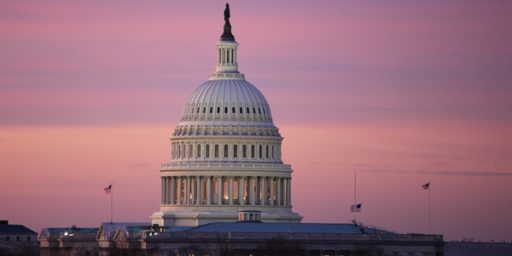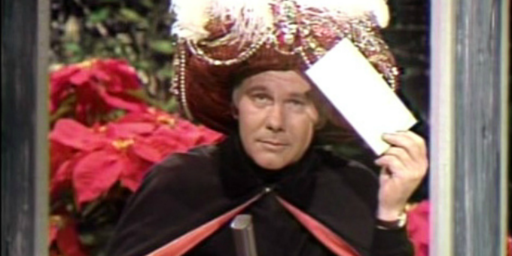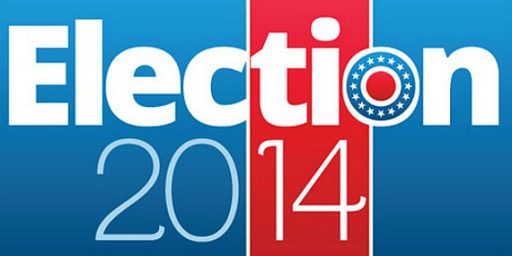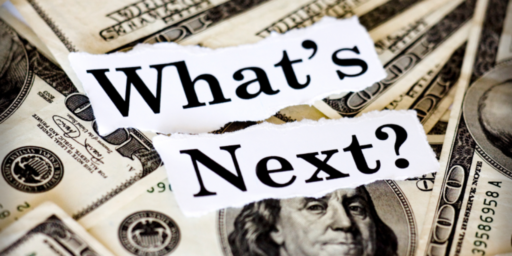2010 vs. 1994 Revisted, Part The Second
Another political analyst is out with a 2010 prediction that should make Democrats very nervous.
Yesterday, James Joyner noted Charlie Cook’s recent, and surprising revision to his predictions for the November elections.
Today, the University of Virgina’s Larry Sabato joins him in forecasting what we may have to start calling a wave election:
2010 was always going to be a Republican year, in the midterm tradition. It has simply been a question of degree. Several scenarios were possible, depending in large measure on whether, or how quickly, the deeply troubled American economy recovered from the Great Recession. Had Democratic hopes on economic revitalization materialized, it is easy to see how the party could have used its superior financial resources, combined with the tendency of Republicans in some districts and states to nominate ideological fringe candidates, to keep losses to the low 30s in the House and a handful in the Senate.
But conditions have deteriorated badly for Democrats over the summer. The economy appears rotten, with little chance of a substantial comeback by November 2nd. Unemployment is very high, income growth sluggish, and public confidence quite low. The Democrats’ self-proclaimed “Recovery Summer” has become a term of derision, and to most voters—fair or not—it seems that President Obama has over-promised and under-delivered.
Obama’s job approval ratings have drifted down well below 50% in most surveys. The generic ballot that asks likely voters whether they will cast ballots for Democrats or Republicans this year has moved increasingly in the GOP direction. While far less important, other controversies such as the mosque debate and immigration policy have made the climate worse for Democrats. Republican voters are raring to vote, their energy fueled by anti-Obama passion and concern over debt, spending, taxes, health care, and the size of government. Democrats are much less enthusiastic by almost every measure, and the Democratic base’s turnout will lag. Plus, Democrats have won over 50 House seats in 2006 and 2008, many of them in Republican territory, so their exposure to any sort of GOP wave is high.
Given what we can see at this moment, Republicans have a good chance to win the House by picking up as many as 47 seats, net. This is a “net” number since the GOP will probably lose several of its own congressional districts in Delaware, Hawaii, and Louisiana. This estimate, which may be raised or lowered by Election Day, is based on a careful district-by-district analysis, plus electoral modeling based on trends in President Obama’s Gallup job approval rating and the Democratic-versus-Republican congressional generic ballot (discussed later in this essay). If anything, we have been conservative in estimating the probable GOP House gains, if the election were being held today.
In the Senate, we now believe the GOP will do a bit better than our long-time prediction of +7 seats. Republicans have an outside shot at winning full control (+10), but are more likely to end up with +8 (or maybe +9, at which point it will be interesting to see how senators such as Joseph Lieberman of Connecticut, Ben Nelson of Nebraska, and others react). GOP leaders themselves did not believe such a result was truly possible just a few months ago. If the Republican wave on November 2 is as large as some polls are suggesting it may be, then the surprise on election night could be a full GOP takeover. Since World War II, the House of Representatives has flipped parties on six occasions (1946, 1948, 1952, 1954, 1994, and 2006). Every time, the Senate flipped too, even when it had not been predicted to do so. These few examples do not create an iron law of politics, but they do suggest an electoral tendency.
Sabato also predicts eight Republican pickups in Governor races, which, if it manifests itself, would be of immense help to the party during the redistricting battles certain to unfold in 2011.
I can hear some of the naysayers now.
It’s too early to predict what may happen in November. Most of the candidates haven’t even held a public debate yet. Maybe the Republicans are peaking too early.
All or one of those may turn out to be true, but as things stand right now, I’ve got to wonder what can possibly occur between now and November 2nd that can turn things around. As I noted on Monday, there doesn’t seem to be much:
The latest round of economic reports seem to establish fairly clearly that the economy is likely to remain flat or depressed during that time period and I doubt we’ll be getting any good news out of the jobs report that will be released this coming Friday, and it is primarily the economy that is driving voter anger at this point in time. Outside of some massive scandal that hurts Republicans or an international crisis that causes the public to rally around the President, both of which are unlikely, the pattern we’re in now is likely to be the one we’re in on Election Day. That’s bad news if you’re a Democrat.
Indeed it is. The idea of the GOP taking over the House is fast becoming conventional wisdom among pundits, how much longer before a Senate takeover goes from being a possibility to inevitable ? Not long, I’m betting.







The idea of the GOP taking over the House is fast becoming conventional wisdom among pundits, how much longer before a Senate takeover goes from being a possibility to inevitable ? Not long, I’m betting.
Is are you talking about the inevitability of the shift punditry wisdom or the inevitability of the actual event? One seems certain, the other not as much.
The narrative is what matters.
Original analysis is hard, whereas regurgitating conventional “wisdom” is something any bubble-headed bleach-blonde who comes on at five can do.
” and to most voters—fair or not—it seems that President Obama has over-promised and under-delivered.”
Rasmussen – Obama’s approval rating on 9/2/2009 = 46%
Rasmussen – Obama’s approval rating on 9/2/2010 = 47%
http://www.rasmussenreports.com/public_content/politics/obama_administration/obama_approval_index_history
I don’t think the slide in Obama’s popularity that most wingnut sites are pushing is all that…real.
Good point Ponce. Its rather stunning eh? It would be interesting to count up all the news media and blog postings over the past year that have referenced Obama’s approval ratings, and count up how many used terms like “plummeting”, “meltdown”. “deteriorating”, “fading”, “falling” etc. vs. how many used variations of “rising”.
And at the end of it, his approval is at the same level! How is that possible?
@ Tano
And at the end of it, his approval is at the same level! How is that possible?
Easy – you’re cherry picking polls with similar levels within the overall fluctuation. You all know fully well that 1) polls are inexact, therefore the trend is what is important, and 2) that there are many, many more samples where Obama’s approval rating is lower than your chosen example. Such as the two day excerpt from Rasmussen, included below
8/25/2010
-20
25%
45%
44%
56%
8/24/2010
-18
25%
43%
45%
54%
The main question you have (paraphrased), “how can Obama be doing badly if his approval rating doesn’t change” , is because you are only acknowledging the polls which give the impression of stability